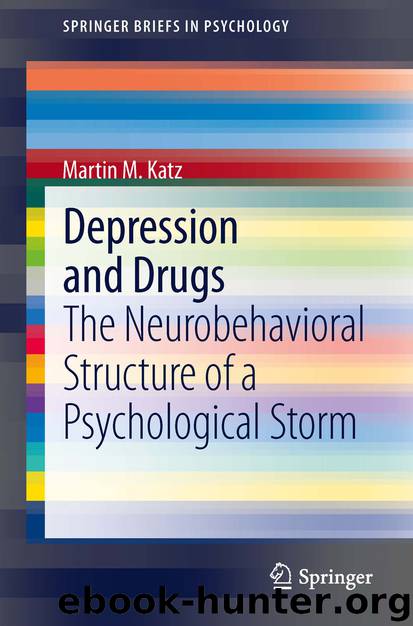Depression and Drugs by Martin M. Katz

Author:Martin M. Katz
Language: eng
Format: epub
Publisher: Springer International Publishing, Heidelberg
Behavioral Correlates of Central Neurotransmitters in the Affective Disorders [13–15]
If as in the collaborative depression study, we examine the chemistry alongside the behavioral aspects of disorder, applying the multifaceted model of depression, we draw a different picture of the role of chemistry in depression than that drawn from the studies utilizing the diagnostic model of the disorder as a whole entity.
In this chapter, we discuss briefly findings from the collaborative depression study and other studies that helped to clarify the relationships between the functioning of central brain neurotransmitter systems and components of behavior in depression, and second, how drugs impact these relationships in the therapeutic process.
As early as 1915, central neurochemical processes were implicated as the neural substrates for emotional and mood states such as anxiety, rage, and fear [16, 17]. Over time, several specific neurotransmitters have been studied as possibly associated with these emotions including the serotonergic, noradrenergic, and dopaminergic. This led eventually to hypotheses that link the functioning of central monoamine neurotransmitters specifically, to the genesis of affective disorders of depression and mania, that is, deficiencies of these neurotransmitters at central neural synapses were postulated to be responsible for depression, excess amounts, for mania.
Much research and controversy has followed from those early studies concerning whether the concentrations of monoamine neurotransmitter metabolites were or were not increased in depressed patients. As late as the 1990s, these issues still remained open, apparently awaiting definitive studies that would determine whether there were specific biochemical markers for the affective disorders. While it remained open, more fundamental questions aimed at the specific relationships between the behavioral states of anxiety, depressed mood and hostility, and functioning of the central neurotransmitter systems have been pursued at the basic or preclinical research level in humans and animals. In view of the emotional and behavioral complexity of the affective disorders, it appears to be more productive to pursue the uncovering of the more basic behavioral-neurochemical relationships before introducing the complexity associated with a “whole” psychiatric disorder. What do these basic studies tell us about the nature of the relationships? What effect do these results have on the manner in which we seek information on the neurobehavioral processes associated with depression and the mechanisms underlying the efficacy of the antidepressants?
Basic studies of the central neurotransmitter systems, the norepinephrine, serotonin, and dopamine systems, find as reviewed earlier that the three have different associations with behavior and the emotions.
How do these findings fit with those already found about the relationships of neurochemical and behavioral variables in depressed patients prior to drug treatment? What happens to these relationships in depressed patients when an antidepressant drug is introduced?
Download
This site does not store any files on its server. We only index and link to content provided by other sites. Please contact the content providers to delete copyright contents if any and email us, we'll remove relevant links or contents immediately.
Rewire Your Anxious Brain by Catherine M. Pittman(18485)
Talking to Strangers by Malcolm Gladwell(13130)
The Art of Thinking Clearly by Rolf Dobelli(10137)
Mindhunter: Inside the FBI's Elite Serial Crime Unit by John E. Douglas & Mark Olshaker(9100)
Becoming Supernatural by Dr. Joe Dispenza(8035)
Change Your Questions, Change Your Life by Marilee Adams(7561)
The Road Less Traveled by M. Scott Peck(7472)
Nudge - Improving Decisions about Health, Wealth, and Happiness by Thaler Sunstein(7456)
The Lost Art of Listening by Michael P. Nichols(7357)
Mastermind: How to Think Like Sherlock Holmes by Maria Konnikova(7160)
Enlightenment Now: The Case for Reason, Science, Humanism, and Progress by Steven Pinker(7083)
Win Bigly by Scott Adams(7032)
The Way of Zen by Alan W. Watts(6449)
Daring Greatly by Brene Brown(6367)
Big Magic: Creative Living Beyond Fear by Elizabeth Gilbert(5552)
Grit by Angela Duckworth(5446)
Ego Is the Enemy by Ryan Holiday(5224)
Men In Love by Nancy Friday(5110)
Altered Sensations by David Pantalony(5002)
